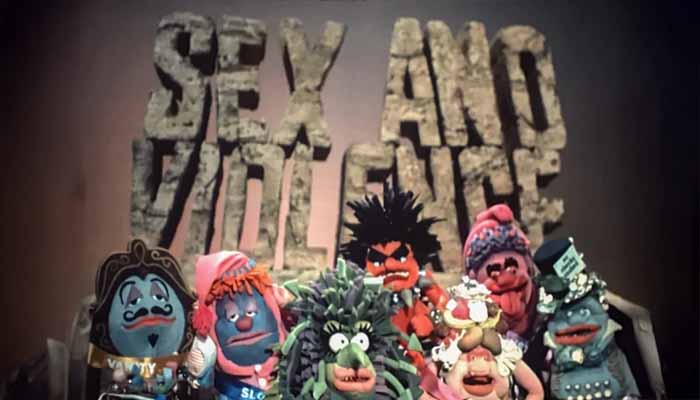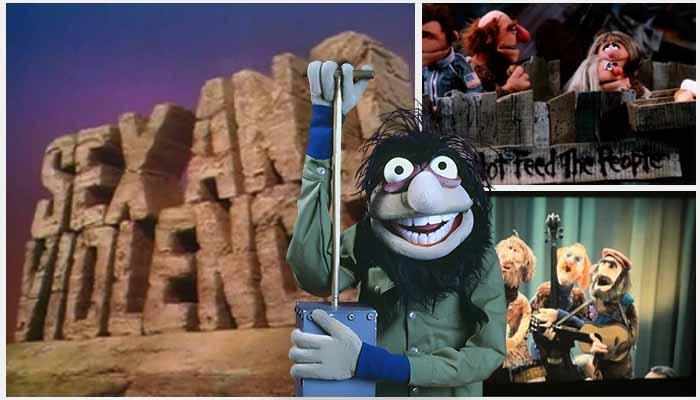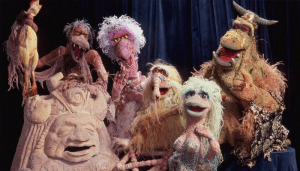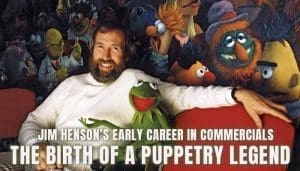Jim Henson. The name conjures images of vibrant felt creatures, whimsical stories, and a legacy of laughter that has spanned generations. While many fondly remember the global phenomenon that was “The Muppet Show,” a lesser-known but equally fascinating piece of Henson’s early work offers a unique glimpse into the development of his comedic genius: “The Muppet Show: Sex and Violence.” This intriguing title hints at a departure from the family-friendly fare most associate with the Muppets, promising a deeper dive into the evolution of Henson’s distinctive vision.
This 1975 television special was the second of two pilots created for ABC, representing an early attempt to bring a Muppet variety show to the small screen. The first pilot, “The Muppets Valentine Show,” aired the previous year in 1974. These two specials illustrate Henson’s initial explorations in finding the perfect formula for a Muppet-led variety program. Filmed in December 1974 and broadcast on March 19, 1975, on ABC, “Sex and Violence” was shot at Metromedia-TV studios in New York City. Initially, Henson informally called the project “The Muppet Nonsense Show”. However, he ultimately insisted on the more provocative title “Sex and Violence,” a decision that caused concern within the network. Henson later explained his reasoning, stating that the title was intended as a humorous hook, and while the show did touch upon contemporary attitudes towards these themes, its primary aim was to satirize them. This reveals Henson’s early inclination to push boundaries and use the Muppets as a vehicle for social commentary, albeit wrapped in a layer of absurdity. Interestingly, when the special was eventually broadcast, the title sometimes appeared in television listings simply as “The Muppet Show” or “The Muppets Show.” This alteration likely stemmed from the recent commitment by major networks to adhere to the Family Viewing Hour rule during the 1975 season, suggesting a compromise between Henson’s artistic intent and network broadcasting standards.

“The Muppet Show: Sex and Violence” unfolded as a half-hour variety show that cleverly parodied the then-prevalent themes of sex and violence on television. The special incorporated a series of distinct sketches and segments. A loose framing device involved Nigel, Sam the Eagle, and Floyd preparing for a “Seven Deadly Sins Pageant,” featuring various Muppets embodying Envy, Rage, Gluttony, Vanity, Lust, Avarice, and Sloth. While this backstage narrative provided a semblance of structure, it remained somewhat detached from the individual sketches presented. One memorable segment featured the faces of Mount Rushmore – George Washington, Theodore Roosevelt, Thomas Jefferson, and Abraham Lincoln – engaging in lighthearted banter and trading jokes. This showcased an early example of the Muppets blending historical figures with their signature silly humor. The special also included a wrestling match where a competitor hilariously named “The San Francisco Earthquake” demonstrated his unique and destructive wrestling style. This sketch likely contributed to the “violence” aspect of the title in a comical and exaggerated fashion. Marking the debut of two iconic characters, the special featured Statler and Waldorf, the now-famous hecklers, in a sketch set in a dentist’s office. Their introduction suggests an early understanding of the comedic potential of audience-surrogate characters offering cynical commentary. Another significant debut was the Swedish Chef, who, in his signature incomprehensible style, demonstrated the process of making a submarine sandwich. The character’s original Swedish name, Järnvägskorsning, meaning “railway crossing,” was later abandoned by Henson. The Muppet band, Dr. Teeth and the Electric Mayhem, made their first appearance, performing the energetic song “Love Ya to Death”. This performance introduced several key Muppet musicians, including Dr. Teeth, Animal, Floyd Pepper, Janice, and Zoot , and exemplified the band’s chaotic and lively musical contributions that would become a hallmark of the Muppets. Notably, this particular musical number was the only segment from “Sex and Violence” that was later reused in the subsequent “Muppet Show” series , indicating its early success and recognition as a quintessential Muppet moment. The special also included a segment called “Return to Beneath the Planet of the Pigs,” a review of a fictional film that spoofed the “Planet of the Apes” sequels. This sketch featured an early version of Dr. Julius Strangepork, initially named Dr. Nauga , and later evolved into the popular “Pigs in Space” comedy sketch series , demonstrating how initial ideas could develop into more prominent features in later productions. Other sketches included male birds attempting to attract females in a jazzy musical number and a segment called “Theater of Things” featuring pencils and a ruler. In total, the special featured an impressive 70 Muppets, all brought to life by a team of 10 puppeteers , highlighting the scale and complexity of Henson’s early Muppet endeavors.
Upon its nationwide broadcast on March 19, 1975, “The Muppet Show: Sex and Violence” garnered a mixed response from contemporary critics. Arthur Unger, writing for The Christian Science Monitor, offered a less favorable assessment. He felt that the humor often fell into extremes, being either too broad and obvious or so subtle that it would be missed by many viewers. Unger also perceived an “elitist quality” to the show, suggesting it was tailored for a specific, intellectually inclined audience, potentially alienating those who only appreciated the more straightforward sight gags. Furthermore, he believed the special lacked the inherent “quality of lovableness” that characterized other Muppet productions like “Sesame Street,” and he noted the absence of beloved characters such as Cookie Monster and Big Bird. Unger concluded his review with a direct plea to Jim Henson to “try again”. This critique underscores the challenges Henson faced in adapting the Muppets for a broader, potentially more adult audience while maintaining the charm of his earlier, more child-focused work. In stark contrast, Thomas Goldthwaite of The Arizona Republic enthusiastically praised the special. He declared it “hands down the most original, innovative thought that ABC has ever had” and enthusiastically described it as “[a] surrealistic romp full of menacing ogling, jerky energy and such intensive fun-making that it’s bound to wipe every other show off the charts with the thoroughness of a Cookie Monster”. This positive review highlights the special’s unique and unconventional nature, suggesting that some viewers appreciated its originality and anarchic energy. Even in more recent times, as seen on platforms like IMDb, user reviews remain somewhat mixed, with one featured review giving the special a rating of 6 out of 10. This indicates that the special continues to elicit varied reactions from audiences, perhaps due to its distinct style and tone compared to the later, more widely recognized “Muppet Show.”
Examining its place within Jim Henson’s early work reveals crucial insights into the evolution of the Muppets. Both “Sex and Violence” and its predecessor, “The Muppets Valentine Show,” were created as pilots for a potential “Muppet Show” series, airing as specials on ABC, though neither was initially picked up for a full series. Henson consciously aimed for a different tone in “Sex and Violence” compared to the first pilot, incorporating recurring gags and a more overtly zany sensibility. “The Muppets Valentine Show” had suffered from a somewhat unclear purpose and format, compounded by a less-than-memorable host. In an attempt to address these issues, “Sex and Violence” made a notable improvement by shifting the setting from a non-descript house to a television studio. This change in environment provided a more logical and familiar framework for a variety show, directly foreshadowing the setting of the later “Muppet Show.” While “Sex and Violence” introduced a backstage narrative centered around the Seven Deadly Sins pageant, this storyline felt somewhat disconnected from the sketches presented on “air”. This suggests that the concept of the integrated backstage narrative, which became a hallmark of “The Muppet Show,” was still in its developmental stages. The choice of host also differed significantly. “Sex and Violence” featured Nigel, a character described as looking like a cross between a frog and a Fraggle, who, despite taking a slightly more active role than the host of “Valentine,” was perceived as less defined and even somewhat boring in comparison to the more outlandish Muppets. This highlights the significance of a strong and engaging central figure in guiding the chaotic energy of the Muppets, a role that Nigel did not fully embody. Furthermore, Kermit the Frog, an already established and beloved character, had a reduced presence in “Sex and Violence,” a decision Henson later acknowledged as a misstep, recognizing Kermit’s crucial importance to the Muppets’ overall dynamic. The development of the backstage concept itself marked a significant step forward. In “Sex and Violence,” the Muppets were portrayed as consciously being part of a show, interacting with each other within that context, a departure from the more isolated performances in “The Muppets Valentine Show”. This nascent exploration of the characters’ lives and relationships behind the scenes laid the groundwork for the rich ensemble dynamic that defined the later series. The following table illustrates some of the key differences between the two pilots:
| Feature | The Muppets Valentine Show (1974) | The Muppet Show: Sex and Violence (1975) |
|---|---|---|
| Network | ABC | ABC |
| Host | Wally | Nigel |
| Setting | Non-descript house | TV Studio |
| Backstage Story | Minimal | Seven Deadly Sins Pageant (separate) |
| Tone | Sappy, slow in spots | Edgy, anarchic, fast-paced |
| Humor | More visual, some implied sex jokes | More restrained, dialogue-driven |
| Kermit’s Role | More prominent | Reduced |
| Key Debuts | Few | Many (Swedish Chef, Statler & Waldorf, etc.) |
Export to Sheets
The themes and style of humor in “Sex and Violence” reflected an ambition to move beyond traditional children’s entertainment. The special directly aimed to parody television’s fascination with sex and violence. The humor was intentionally more mature, seeking to appeal to a broader audience beyond just children by tackling themes like romance and aggression. The pacing of the special was notably fast and chaotic, often likened to channel surfing, with sketches frequently broken up into recurring segments. This rapid-fire approach, while perhaps contributing to the special’s unique energy, may also have been a factor in its mixed reception, potentially feeling disjointed or overwhelming to some viewers. Compared to later Muppet productions, the humor in “Sex and Violence” leaned more heavily on dialogue rather than purely visual gags. The introduction of Statler and Waldorf, with their sharp and cynical commentary, perfectly exemplifies this shift towards more verbal wit. Despite its provocative title, the special itself did not actually feature much explicit content related to sex or violence; the title served more as a satirical statement and a “humorous hook”. The opening scene, with Crazy Harry gleefully detonating a sign reading “SEX AND VIOLENCE” as an off-stage announcer declares “the end of sex and violence on television,” underscores this ironic intent. Interestingly, the humor in “Sex and Violence” was actually more restrained compared to “The Muppets Valentine Show,” which contained some surprisingly suggestive jokes, whereas “Sex and Violence” had none. Ultimately, the special sometimes felt like a somewhat random collection of Muppet sketches without a strong unifying point, which may have contributed to its failure to secure a series order.
When comparing “Sex and Violence” with the later, highly successful “Muppet Show,” several key differences emerge. The most significant distinction lies in the role of the host. While Nigel helmed “Sex and Violence,” Kermit the Frog became the undisputed and beloved host of “The Muppet Show”. Nigel’s performance was generally considered passive and lacking in the energetic engagement that Kermit brought to the stage. The importance of a strong, central figure like Kermit in managing the Muppets’ inherent chaos proved to be a crucial element for the series’ success. The pacing also differed considerably. The warp-speed, chaotic rhythm of “Sex and Violence” gave way to a more controlled pace in “The Muppet Show,” allowing sketches to develop and breathe. This more balanced approach likely made the humor more accessible and enjoyable for a wider audience. Furthermore, the structure of “The Muppet Show” was more defined, seamlessly integrating backstage storylines with the on-stage performances and featuring guest stars who actively interacted with the Muppets. The inclusion of celebrity guests became a signature element of the series, adding another layer of comedic potential. Despite these differences, “Sex and Violence” contained several elements that foreshadowed the future success of “The Muppet Show”. It marked the first appearances of many key characters who would become central to the series, including Floyd, Animal, Janice, Zoot, the Swedish Chef, Statler, Waldorf, Nigel, and Sam the Eagle. The special also featured the debut of the “At the Dance” sketch. Moreover, it further developed the concept of the Muppets as performers within a show, interacting with each other backstage. The attempt to appeal to a broader audience with more mature humor, even if not fully realized, also pointed towards the direction “The Muppet Show” would eventually take.
“The Muppet Show: Sex and Violence” holds significant importance in Jim Henson’s career as a testament to his willingness to experiment and push the boundaries of his creative work. The very title itself was a bold and provocative statement. The special demonstrated that the Muppets could engage with more mature subject matter, albeit in a family-friendly context, exploring themes beyond typical children’s entertainment. It played a crucial role in the development of the Muppet formula for a variety show, representing a more edgy and anarchic approach compared to the sweeter tone of “The Muppets Valentine Show”. Both pilots ultimately informed the direction that “The Muppet Show” would take, eventually finding a successful balance of “gentle chaos”. Notably, in this pilot, Henson consciously took a step back from performing as many characters, expressing a desire to focus more on the creative and managerial aspects of the production. This suggests a pivotal point in his career where he began to transition towards a more behind-the-scenes role in the Muppets organization.
In the broader context of television history, “The Muppet Show: Sex and Violence,” while not a mainstream success in itself, holds a unique place. It aired during a period when networks were increasingly mindful of content due to the Family Viewing Hour rule, which may have influenced the network’s reaction to the title and the ultimately somewhat toned-down content. The special’s lasting impact lies in its contribution to the evolution of the Muppets. It introduced numerous iconic characters and comedic elements that would become integral to the success of “The Muppet Show.” It demonstrated the potential for a Muppet-led variety show, even if the execution in this particular pilot wasn’t perfect. Furthermore, “Sex and Violence” has been referenced in later Muppet productions and by individuals involved with the Muppets, indicating its enduring, albeit perhaps niche, status within Muppet lore. For instance, clips from the special were featured in “The Muppets: A Celebration of 30 Years,” and Jason Segel mentioned the pilot’s title on “The Tonight Show with Jay Leno”. These references highlight that “Sex and Violence,” despite its short original run, remains a recognized and significant early step in the Muppets’ journey to becoming a global television phenomenon.
In conclusion, “The Muppet Show: Sex and Violence” stands as a bold and intriguing, though ultimately flawed, early attempt at a Muppet variety show. Its significance lies not in its immediate success, but rather in its role as a crucial stepping stone in Jim Henson’s remarkable career. It showcased his willingness to experiment, highlighted the development of key characters and comedic concepts, and ultimately paved the way for the creation of the beloved “Muppet Show.” This somewhat wild and unconventional pilot offers a fascinating glimpse into the creative process behind a television phenomenon, reminding us that even the most cherished creations often have unconventional and experimental beginnings.




